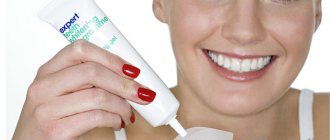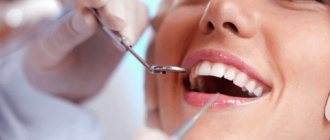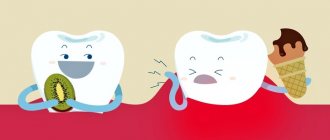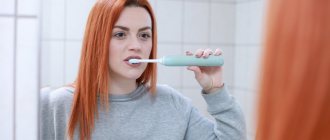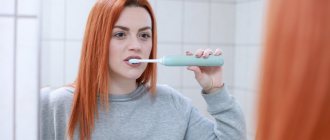- Why does enamel darken?
- Frequent mistakes and misconceptions
- How to remove stubborn plaque? Mechanical
- Enzymatic
- Light
- Toothpastes with peroxides
There are many misconceptions associated with whitening: some believe that it damages the enamel, others that it only works in the dentist’s chair. In fact, you can safely lighten your teeth several shades at home, without any medical skills. Today we will talk about the nature of enamel darkening and the means by which you can whiten your teeth without harm.
Composition of whitening gels
Teeth whitening gel contains hydrogen peroxide, which reacts chemically with pigments and causes its destruction. With the help of such products, you can successfully cope with the darkening of the enamel caused by smoking, frequent consumption of coffee, tea and other products that can stain the crowns of teeth. The products differ in the content of the active component.
The concentration can vary between 4-7.5%. As a rule, the hydrogen peroxide content in home remedies is not high, but professional formulations are more active. This is due to the fact that hydrogen peroxide can be harmful if it comes into contact with mucous membranes. When it is necessary to remove slight darkening, gels containing urea can be used. It has an abrasive effect, but is safe for teeth.
How much does it cost to whiten teeth?
At-home teeth whitening is significantly less expensive than professional in-office whitening. For example, office whitening such as Zoom will cost you from 15,000 rubles, not counting the cost of a special kit for maintaining results at home. Together with such a set, the total cost of whitening can reach 25,000 - 30,000 rubles.
If you are faced with the question: how to whiten your teeth at home effectively and without harm, then the “Opalescence” home teeth whitening system from ULTRADENT (USA) or “Perfect Bleach” from VOCO (Germany) will help you with this. Strips under the Crest 3D White brand (USA) will be slightly less effective. The cost of all these funds is quite reasonable...
How much does it cost to whiten teeth at home in 2022 –
- Strips for home whitening Crest 3D White – from 2500 to 5500 rubles.
- Teeth whitening Opalescence will cost you 4000-4500 rubles. (however, if you decide to make individual trays for teeth whitening, the price of 2 trays for the upper and lower jaws will be an additional 2,000 rubles).
- Whitening paste “Rembrandt plus” (USA) – from 1000 rubles per 50 ml tube.
Contraindications
Gel teeth whitening has side effects, so it should not be used in the following cases:
- During pregnancy and breastfeeding.
- Patients with caries, gum disease.
- Allergy to the components of the product.
- Crowns and fillings.
- High sensitivity of teeth.
Use teeth whitening gel with caution when correcting a bite with braces. Braces are not a direct contraindication to whitening, but due to the way they are fixed to crowns, the product may be distributed unevenly and stains may appear on the teeth.
Consulting algorithm
We answer questions live on VKontakte: https://vk.com/pharmznanie
You can discuss the latest news with all your Russian colleagues in chats: Telegram: https://tglink.ru/pharmordenVKontakte: https://vk.me/join/AJQ1d_D2XxaDy9IdzL0e6EqH To leave a comment on the article, you need to register or log in.
Interested in the article? You can find out even more in the section Working in a pharmacy
Professional whitening
Although some whitening gels are suitable for home use, it is best to have the procedure done at a dental clinic. The fact is that hydrogen peroxide is aggressive towards mucous membranes, and it is very important to carefully isolate them. This is not always possible at home, and there is a risk of getting irritation or chemical burns.
Professional whitening is carried out in several stages:
- The doctor carefully isolates the mucous membranes. Typically, a cofferdarm is used for this - a special latex plate that allows you to isolate the teeth from the rest of the oral cavity.
- The composition is applied to the surface of the enamel. It is important to distribute the product evenly, otherwise the whitening will be of poor quality.
- To activate the chemical reaction, the doctor uses a special lamp on the gel-coated teeth. The released active oxygen reacts with pigments and destroys them. The duration of the procedure depends on the original and desired color. Typically, the patient spends 30 minutes to an hour in the dentist's chair. You can lighten your teeth by 4-6 tones.
Teeth whitening gels can be used repeatedly, but the procedures cannot be carried out very often. Listen to your doctor's recommendations. In non-smoking patients who maintain oral hygiene and do not abuse coffee and tea, the effect lasts up to 3-5 years.
Why do teeth turn yellow and darker?
The hard tissues of the tooth consist of two layers - translucent enamel and underlying darker dentin. Over the course of life, the enamel on the teeth becomes thinner, which causes the darker layer of dentin to increasingly affect the overall color of the teeth. It is also important that dentin itself (with age) tends to become darker, thereby changing the optical properties of teeth.
Secondly, personal habits regarding the consumption of various foods and drinks are of great importance -
- tobacco use,
- black tea and coffee,
- red and white wine,
- carbonated drinks,
- berries and other foods rich in dyes,
- sauces (soy, tomato, curry).
Thirdly, teeth acquire a duller, grayer shade as a result of their depulpation (removal of the nerve and subsequent filling of the canals). Fourthly, after filling the root canals, the tooth may acquire a bluish color, which occurs as a result of mistakes and negligence of the dentist, if at the time of introducing filling materials into the root canals, traces of blood remain on their walls.
Home whitening
The gels are also suitable for home use, but you cannot do without a visit to the dentist. The doctor will make a special tray filled with bleaching agent. You wear this mouth guard at home for about 4 hours a day. The first visible effect appears on about 4-5 days.
Unlike professional whitening, the home procedure does not significantly change the color of the enamel. But if the darkening is slight, a mouth guard is a simple and convenient way. The disadvantage of home treatments is that they need to be repeated regularly to maintain tone. Usually 3-4 short sessions are recommended twice a year.
You cannot whiten your teeth with activated carbon, soda and hydrogen peroxide -
Can cheap products like baking soda, activated charcoal or hydrogen peroxide help whiten teeth? Indeed, they may have a small effect, but the possible negative effects on the enamel of teeth and gums will significantly exceed the potential benefits. Let's figure out why this is so.
1) Teeth whitening with activated carbon: reviews
If you decide to try whitening your teeth with activated carbon, you should know that activated carbon is an abrasive (like tooth powder). Unlike abrasives that are included in toothpastes, activated carbon crystals are not spherical, and therefore its use will lead to the appearance of small scratches on tooth enamel.
At the initial stage, you may notice that there is a little less pigment plaque, because... the abrasive will scrape off the plaque. However, microscratches will make the surface of the teeth rough, and pigment and microbial plaque tend to stick to rough surfaces even faster. Conclusion: charcoal has a mechanical/abrasive effect on pigment plaque, scratches and damages tooth enamel, so it should not be used.
2) Teeth whitening with soda (consequences) –
Reviews of teeth whitening with soda are not very positive. Baking soda can indeed slightly lighten surface stains on tooth enamel (pigment deposits), but like activated carbon, regular baking soda also has a fairly high degree of abrasiveness. Therefore, adding a large amount of soda to your toothpaste can also lead to micro-scratches on the enamel of your teeth. Still, it is much safer to use professional whitening toothpastes, which contain high-quality spherical-cut abrasives. The latter are guaranteed not to scratch the enamel of your teeth.
3) Teeth whitening with hydrogen peroxide: reviews
Teeth whitening at home with hydrogen peroxide is theoretically possible, but in practice it is very difficult to do, and because of this, it has a large number of side effects (complications). Hydrogen peroxide in whitening products for home and professional use is used in the form of a gel, which is in close contact only with the surface of the teeth (and at the same time must be isolated from the gums and excessive contact with saliva).
At the pharmacy you can buy hydrogen peroxide with a concentration of 3% or 6%. The only thing you can do is soak cotton balls or a gauze pad with peroxide and apply it to your teeth. Why is this ineffective... If gauze and cotton swabs come into contact with saliva, the procedure can be immediately called ineffective. Upon contact with the organic components of saliva, the peroxide will immediately begin to disintegrate (although the minimum time required to achieve the effect when using 6% peroxide is 1 hour).
But the rapid decomposition of peroxide occurs not only from contact with saliva, but also on its own. This is where the main advantages of professional home systems lie: they contain carbamide peroxide gel in a fairly high concentration, but from which hydrogen peroxide is released gradually. The latter allows you to maintain an effective concentration of hydrogen peroxide for a long time.
Well, one more thing: if hydrogen peroxide comes into contact with the gum, you will get a chemical burn (the gums will turn white), which can then even lead to gum recession. In addition, if you do all this without gloves, your fingers will turn white, also due to a chemical burn to the skin. Therefore, there are only negative reviews for home teeth whitening with hydrogen peroxide.
4) Why you can’t whiten your teeth with lemon (or other acids) –
Citric acid, as well as any other acids, cause the leaching of calcium from the surface layer of enamel. Due to a sharp decrease in enamel mineralization, this process really looks like teeth whitening. The color of the teeth becomes dull (chalky), the surface of the enamel becomes rough, and in addition, the teeth will lose their shine.
Those. There will be not just a deterioration in the appearance of the teeth, but also a decrease in the resistance of the enamel to mechanical stress, as well as to the effects of cariogenic bacteria. As a result, rapid wear of the enamel and multiple dental caries.
Flaws
Gel whitening is not suitable if you have fillings or crowns. Active oxygen is able to react with pigment accumulated on the surface of the enamel, but it cannot affect filling materials or ceramics. This is due to the fact that their structure is different from natural tooth enamel.
If you have a problem similar to that described in this article, be sure to contact our specialists. Don't diagnose yourself!
Why you should call us now:
- We will answer all your questions in 3 minutes
- Free consultation
- The average work experience of doctors is 12 years
- Convenient location of clinics
Single contact phone number: +7
Make an appointment
Sources:
- Personal experience as a dentist;
- Krikheli, N.I. Teeth whitening and enamel microabrasion in aesthetic dentistry. Modern methods / N.I. Krikheli. - M.: Prakt. medicine, 2008;
- Semchenko, I.M. Teeth whitening techniques: method. allowance / I.M. Semchenko, A.I. Delendik. -Minsk: BSMU 2007;
- Terekhova, N.V. The effectiveness of clinical whitening of pulpless teeth in young people / N.V. Terekhova // Present and future of postgraduate education: materials of the rep. scientific-practical conf., dedicated 75th anniversary of BelMAPo.-2006;
- Addy, k The comparative tea staining potential of phenolic, chlorhexidine and anti-adhesive mouthrinses / A.Addy, J.Moran, R.Newcombe, P.Warren // J. Clin. periodontol. - 1995;
- Sulieman M. An overview of tooth-bleaching techniques: chemistry, safety and efficacy / M.Sulieman // Periodontology. - 2008;
- Vogel RI Intrinsic and extrinsic discolouration of the dentition / RI Vogel // J. Oral Med. - 1975;
- Watts A. Tooth discolouration and staining / A.Watts, M.Addy // Br. Dent. J. - 2001. - N 190.
